With everything going on in your busy life, it’s challenging to know where to start when it comes to your finances. Look no further: this article has you covered.
Before making any moves, your first step in managing your finances is to evaluate your current financial standing. Are you Scrooge McDuck swimming in hard cash or are you on the verge of selling your kidney to pay off some debt? After we nail this down, we’ll cover the seven financial priorities you should use as your financial roadmap.
Your Current Financial Status
Before establishing any financial priorities, it’s important to first assess your current financial status. By financial status, we mean how much you own compared to how much you owe. Even write it down, drawing a line down the middle and labeling the left, Things I Own (Assets), and the right, Debt (Liabilities). Consider this your personal “balance sheet”:

For the left side, take a general inventory of everything you own: money in bank accounts (e.g., checking and savings accounts), investments, money in retirement accounts (e.g., 401(k) and IRA), your home (estimate of current market value), your car, your jewelry, etc. For the right side, list all of your debt: credit card debt, student loans, remaining mortgage, etc. Don’t worry about making these amounts exact—estimates are fine. You just want to have a mental “picture” of your current financial status. If you have a partner or dependents (e.g., children), include their assets and liabilities as well. Here’s an example personal balance sheet for your reference:
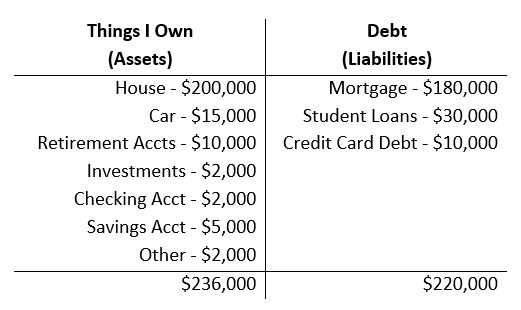
In this example, the family has $236,000 in assets and $220,000 in liabilities. The difference between these two amounts (i.e., assets – liabilities) is the individual/family’s equity. In this example, the equity is $16,000.
Based on your personal balance sheet, do you have more assets than liabilities (i.e., positive equity)? Or do you have more liabilities than assets (i.e., negative equity)? By how much? Your age will likely have a large impact on your current equity. Are you in your 20s and therefore likely to have few assets and high student loans, or are you in your 50s and preparing for retirement?
Finally, consider how much cash you have and how much in assets you would be able to quickly convert into cash (a concept known as liquidity). For instance, if the family above had to make an emergency cash payment of $10,000 (e.g., for an unexpected hospital visit), do they have cash readily available to make the payment? The money in checking and savings accounts is cash, but that’s only $7,000. Depending on the types of investments, the family may or may not be able to sell the investments immediately and convert the investments into cash. Assuming the family sells the $2,000 in investments for cash, they would still need to find another $1,000. This is not an ideal scenario as your house and car are illiquid and you generally do not want to tap your retirement accounts or rack up credit card debt. We’ll discuss options you have in this scenario in later posts, but it’s important to assess how much cash you have available on a consistent basis.
Smart Priorities
Your financial priorities will transition over the different stages of your life. After high school or college, in addition to finding a rewarding job, you generally want to establish an emergency fund, pay off debt and start saving. Gradually, as you (hopefully) establish your career over your 30s and 40s, you want to ramp up your savings. During your 50s, as you approach retirement, you want to continue saving but scale back on risk in order to avoid a large loss just before retirement. Beginning in your 60s, you want to evaluate Social Security/Medicare timing and manage the retirement savings you’ve been accumulating since your 20s. Then, during retirement, as Jimmy Buffet says, you can waste away in Margaritaville.
General, recommended strategies by age are as follows:

Obviously, life doesn’t always go as expected. Everyone’s circumstances are different, and one moment or event can completely change these strategies. For instance, if you have a child or family member in need of significant healthcare expenses or if you must spend money to support the well-being and/or survival of a loved one, that will clearly take precedent. Always put things in perspective. Understand these are general guidelines and not the perfect strategy for each individual or family.
With this in mind, however, there are certain financial priorities you should follow regardless of your age. These priorities—numbered in sequential order from one to seven—will help you prepare for emergencies and save the most money for a financially secure future. The priorities are as follows:
- Establish fund for immediate obligations (e.g., rent, food, minimum debt payments)
- Establish emergency fund (3–6 months of living expenses)
- Contribute to employer retirement plan to maximize employer match
- Pay off all high-interest-rate (7% +) debt, working down from highest-interest debt first
- Invest maximum amounts in tax-advantaged accounts (e.g., 401(k) and IRA)
- Pay off all remaining debt (i.e., low-interest-rate debt)
- Invest in non-tax-advantaged accounts
Let’s take a look at each of these seven priorities:
Priority 1: Establish immediate obligation fund
Your first financial priority—before paying off debt, saving for retirement or otherwise investing—should be to make sure you have enough money to cover your immediate obligations until your next paycheck or source of income. This includes paying both your ongoing bills (e.g., rent, food, utilities, transportation, ragers, whatever) and your minimum payments on ALL debt.
The size of this immediate obligation fund depends on (1) your amount of current living expenses, including minimum debt payments, and (2) whether or not you have a job/source of income or are confident you will have a job/source of income in the near future. If you’re renting a beachside penthouse near Los Angeles and make it rain with $100 bills every Friday night (not judging), your immediate obligation fund will be pretty hefty. On the other hand, if you’re renting your buddy’s floor for $10 a month and surviving on ramen noodles (not recommended), your immediate obligation fund can be significantly smaller. Likewise, the longer the time period until your next paycheck or source of income, the larger your immediate obligation fund needs to be. In most instances, your immediate obligation fund should be around one month of living expenses.
The purpose of this first priority, other than providing you with life’s bare necessities, is to prevent you from going any further into debt. If you have no debt, great! Continue to PAY YOUR BILLS (we’re trying to move forward here, people). If you do have debt, be sure to make the minimum periodic (e.g., monthly) payments; and if you’re unable to make all minimum payments, make payments on your debt with the highest interest rates first. Whether it’s your credit card, mortgage, student loans or other loans, paying your minimum debt payments on time and in full is critical to establishing a strong financial foundation.
Importantly, make a mental note that this is not your emergency fund. This is just your initial step to provide yourself a cushion before saving for additional months of living expenses.
Priority 2: Establish emergency fund
The next step is to save your emergency fund (yes, another fund, already). The immediate obligation fund you saved in Priority 1 doesn’t actually prepare you for emergencies or unexpected expenses; rather, it’s just large enough to cover your ongoing obligations before your next paycheck or source of income. Your emergency fund ensures you don’t run out of cash when faced with a loss of job or unexpected expenses—such as car maintenance, medical bills or home repairs—which would otherwise force you into more debt.
Your emergency fund should equate to approximately three to six months of living expenses. Once again, this amount clearly depends on your current living expenses and sources/timing of income. Estimate your monthly living expenses and multiply this amount by three (if you are a risk taker) or six (if you would like to be conservative). This is the total amount you need to save for your emergency fund. For those living paycheck to paycheck, saving an emergency fund can be a challenging step. However, focus on strict budgeting as emergency fund savings are crucial to avoid racking up credit-card debt, which—as we’ll discuss more later—is the devil of the financial world itself.
Priority 3: Maximize employer match
If your employer or agency offers an employer-sponsored retirement plan—including a 401(k), 403(b), 457, Thrift Savings Plan, Solo 401(k), SEP IRA or SIMPLE IRA—make sure you take advantage of any employer match. For these retirement savings plans, many employers offer to match your contributions up to a percentage of your salary. This is FREE MONEY! People stampede over one another to get to free food, but many don’t bother with the limited effort to score free money from their employers: it’s mind-boggling.
One of the biggest mistakes you can make, especially for those of you just starting your careers, is not contributing the maximum percentage of your salary at which your employer will match. What does this mean? As an example, your employer may match 50% of your contributions on the first 6% of salary you contribute. In this situation, you would want your contribution percentage to be at least 6%. Some companies may even match your contributions dollar-for-dollar, although this is rarer. It’s important for you to know (or ask) up to what percentage of your salary your employer will match as this is the minimum contribution you should make to your employer-sponsored retirement plan each year.
Priority 4: Pay off all high-interest-rate debt
Not all debt is bad. In fact, there’s actually such a thing as “good debt,” but only when necessary and only when you have the capability to make at least the minimum payments on the debt.
Good debt includes borrowing that will provide long-term financial benefits. How could borrowing provide long-term financial benefits? Consider student loans. You take student loans to pay for an education, which (hopefully) leads to a degree and (hopefully) then leads to a higher-paying job. The earnings from that job, when compared to the earnings from the job you would have had without your degree, will undoubtedly pay off the student loans and earn you significantly more money over the course of your life. This table provides examples of debt you should be willing to incur, if necessary:
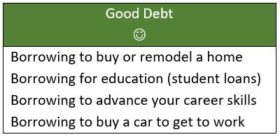
Bad debt, on the other hand, is borrowing for short-term benefits. This includes, sorry to say, almost everything we love…food, drinks, vacation, clothing and entertainment. But these expenses are perfectly fine IF YOU HAVE THE MONEY. If you don’t have the money, these are the expenses that will leave you doomed (and maybe even undateable!). In the case of this kind of borrowing, it’s “mo money, mo problems.” Just ask 50 Cent, Mark Twain (if he were alive), Lindsay Lohan (if she’s sober) or even Meat Loaf (Ma! The meatloaf!): not exactly your best role models in the financial platform. This table shows some of the items for which you should avoid borrowing at all costs:
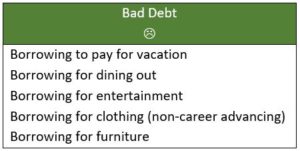
Although debt isn’t necessarily bad, too much debt is. Debt becomes especially critical when you are unable to make the minimum payments on your debt (remember, this was covered in Priority 1). Your debt will compound and spiral you into a mess of misery. Avoid this like the plague (or even COVID-19).

After setting aside your immediate obligation and emergency funds and maximizing your employer match, prioritize paying off all of your high-interest (i.e., greater than 7%) outstanding debt, starting with the debt with the highest interest rate. If you have no high-interest-rate debt, keep up the good work, pass GO and move on to Priority 5. Otherwise, keep on reading.
Many people are tempted to pay off their smallest debt balance first; however, while this provides you a mental reward and maintains your debt-paying momentum, you can strategically pay the least amount of total interest by paying off your highest-interest debt first (while making minimum payments toward the others). It’s important to emphasize that this strategy requires commitment: if you lose confidence or momentum and neglect to continue paying off the highest-interest debt, your interest payments will only get worse.
Interest rates for debt instruments vary based on several different factors. These factors include the time period of the loan, your credit score, supply and demand in the market and the debt instrument itself. The table below provides general interest rate ranges for each debt instrument:
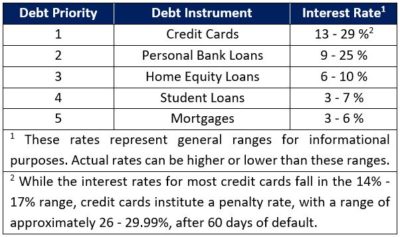
As the priority order and ranges in the table above may not apply to your scenario, make a list of all of your outstanding debt with their corresponding interest rates (this will require some reading of statements and/or contracts on your part). Then place them in order from highest-interest rate to lowest-interest rate. This is your debt payout priority schedule.
Using your debt payout priority schedule, draw a line to separate any debt with an interest rate greater than 7% from any debt with an interest rate of 7% or less. You’ve now just separated what we’ll consider your “high”-interest-rate debt (Priority 4) vs your “low”-interest-rate debt (Priority 6). Why 7%? Historically (not guaranteed), you can earn greater than 7% over the long term by investing your money in a diversified portfolio or tax-advantaged retirement account. We’ll cover more on rates of return in another post; for now, focus on paying off all of your high-interest-rate debt in FULL.
It’s likely you have credit card debt at the top. Credit card companies are notorious for charging high interest rates on debt, especially when taking into account the penalty rate. Federal law allows credit card issuers to impose a penalty interest rate if you become more than 60 days delinquent on your credit card payment. With this in mind, make sure you know which interest rate is applicable to your current payment status for your credit card.
An example can help drive this point home. Say you have a $5,000 outstanding balance on a credit card and your interest rate (penalty rate) is 29%. Surely waiting one year to pay it off won’t matter much, will it? WRONG! Try over $1,600 in extra interest, bringing your new balance to more than $6,600. It should make you feel even worse that you will be paying interest on your interest (insert face palm emoji here). Think of all the other things $1,600 could go towards.
To be clear, this priority is not easy. It will take grit, accountability and commitment to your budget, even if it takes several years to clear this hurdle. But, as you will hear over and over again, this step is key to a strong financial start, which is why it immediately follows your initial savings and employer match. With this in mind, if you determine you can decrease your initial obligation fund, put the extra money to paying off your highest-interest debt. It’s unlikely that you’ll earn more in savings than you can “earn” (in avoided interest) by paying off your high-interest-rate debt. Stay dedicated, stay motivated and get rid of that pesky debt once and for all.
Priority 5: Invest in tax-advantaged accounts
Priority 4 is one of the most challenging priorities, so congratulations are in order if you’ve reached Priority 5. If you’ve already run out of cash to reach this step, that’s ok! This is a financial marathon, not a sprint. These are priorities, so as long as you’re focused on these priorities, you’re on track for financial security. Let’s keep rolling…
Almost everyone hates the IRS, except those who work for the IRS. They never seem to provide any good news, and you definitely don’t want to hear from them. But everyone should give the IRS a call to thank them for tax-advantaged accounts. These are wonderful gifts from the government. The only thing is, a lot of people don’t take advantage of them! That’s like telling Santa to go back up the chimney because you don’t want his presents. Bunch of Grinches.
Taxes play a MUCH more important role in our everyday finances than most of us want to know. The government takes a look at what they want us to do, and they incentivize us to do it by reducing the associated taxes. For example, the government wants us to save for retirement, so they created tax-advantaged retirement accounts (e.g., 401(k)s, IRAs, 403(b)s, 457s, Thrift Savings Plans, SEP-IRAs, Solo 401(k)s); they want us to save for education, so they created education tax credits and tax-advantaged education accounts (e.g., 529s and Coverdell Education Savings Accounts); they want us to buy homes and real estate, so they provide tax deductions for mortgage interest; and they want us to save for healthcare expenses, so they created tax-advantaged health savings accounts (e.g., HSAs and FSAs).
What the heck do all these letters and numbers mean? We’ll cover the basics of these and which are best for you in later posts. What’s important to understand right now is that these plans exist, and you should take advantage of them up to the allowable limits prior to investing in non-tax advantaged accounts.
After you’ve saved for your initial obligations (Priority 1) and emergencies (Priority 2), secured any employer match on your retirement plan (Priority 3) and paid off all high-interest-rate debt (Priority 4), you want to invest in tax-advantaged accounts, most notably of which are tax-advantaged retirement accounts. If you started contributing to your employer-sponsored plan in Priority 3, you’ve already started this step. But—try to contain your excitement—there’s more! Tax-advantaged retirement accounts include the following two separate groups of accounts:
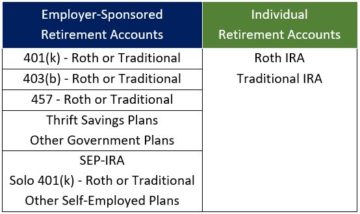
You want to invest in BOTH employer-sponsored retirement accounts and individual retirement accounts, if eligible.
The plans on the left are employer-sponsored retirement accounts, so these plans are limited to those of you employed by companies or agencies that offer such plans. As discussed earlier in Priority 3, check with your employer to determine whether any of these plans are available to you.
The plans on the right are individual retirement accounts (IRAs). Whereas the plans on the left are employer-specific, anyone can contribute to an IRA (as long as you have some income). Therefore, assuming you’ve reached this priority, you have no excuse to not invest in an IRA each year.
Each of the plans above has certain limits for how much you can contribute each year. For example, excluding certain limitations, in 2021 the IRS allows you to contribute $6,000 to your IRA (plus an additional $1,000 if you’re age 50 or older). For employer-sponsored plans, the limit is higher: the 2021 limit for most of these plans is $19,500 (plus an additional $6,500 if you’re age 50 or older). Priority 3 focused on the minimum amount you should contribute to your employer-sponsored retirement plan to maximize any employer match. Now, in Priority 5, you should strive to contribute to both your IRA and employer-sponsored plan up to the designated limits imposed by the IRS each year. We will cover each of these plans and how to set them up in later posts.
Beyond tax-advantaged retirement accounts, you should also take advantage of other tax-advantaged accounts (e.g., education savings accounts, health savings accounts and commuter benefits) if (1) you are eligible, (2) you are confident your emergency fund and other savings will prevent you from tapping these accounts early and (3) you plan to spend money on the plan’s allowable expenses in the future. All of these tax-advantaged accounts, as discussed in more detail in other posts, provide you with considerable (oftentimes 20-40%) savings.
Priority 6: Pay off all remaining debt
Deciding between the next two priorities (6 and 7) requires some judgement on your part. You need to ask yourself which will be higher: the interest rate on your debt (e.g., 4% on your student loans) or the rate of return on potential investments. The simple answer, and the answer which we recommend, is to pay off the remaining balance on all low interest debt, with the exception of your mortgage (which generally has a lower interest rate and tax incentives), before investing in non-tax-advantaged accounts.
The reason? Debt interest is a guaranteed “return,” whereas investing in the market is far from guaranteed. For instance, assume you’ve saved an extra $20,000 and have outstanding student loans of $20,000 with an interest rate of 4%. If you pay off your student loans in full, you have guaranteed yourself a return of 4% (tax considerations aside) by removing that interest payment in the future. Say instead you decide to invest the $20,000 in the stock market and the market tanks 30% (yes, this is possible: stocks dropped around 37% during the 2008 market crash, even though they more than recovered within a few years later). Now not only do you still have $20,000 of student loan debt on which you owe 4% each year, but you lost $6,000 in the stock market! This is an extreme example, but this goes to show the value in paying off “guaranteed” returns.
So, pay off any remaining debt and never, ever look back!

Priority 7: Invest in non-tax-advantaged accounts
Reach this point and you officially have a solid financial foundation. You’ve set aside key savings, paid off all debt and maxed out your annual retirement account contributions. But this doesn’t mean you should disappear to la-la land and ignore any remaining funds or income.
Considering inflation increases on average 2% each year, if you store all of your money in your mattress or a savings account earning 0.1% interest, you will actually lose money over the course of your life (i.e., your money will lose its purchasing power). Therefore, you have to invest. Investment options range from safer investments such as money market funds, certificates of deposit (CDs) and bonds to risky investments such as stocks, real estate, derivatives and hedge funds. Your goal should be to have a low-cost, diversified investment portfolio. We will conquer the topics of how to invest, how much to invest and what you should invest in within another post.
Subsequent Priorities
Once you master these seven priorities, you can focus on saving for your children’s education, building wealth, planning your estate and giving back to others. Whew! So many responsibilities. But if you can pay off all your debt and start investing, you’re well on your way.

This needs to be in money textbooks
Thank you, Elisabeth. I agree!
Sharing with my class!
Glad to hear it, Alec. Please keep sharing!
I’m a big fan of Investopedia but even they don’t have something this straightforward
Thanks, Fran! Straightforward is what I’m going for with this
Priorities 1-7: Don’t spend money you don’t have
That’s certainly important. Thanks for reading!
Excellent
Thanks again, Nancy
If only it were this easy. Most of us are stuck in Priority 1
Fair point, and you’re definitely not alone. Remember to keep priority 2 in mind whenever you have the opportunity to escape priority 1. Good luck, and thank you for reading!
Hi! I’m a mentor for underprivileged youths and shared this – they loved it! Thank you for sharing
That’s great, Genny. Thank you for the support!
I disagree with paying off ALL low interest rate debt before investing in non-tax advantaged accounts. There’s a lot of benefit in having low interest
Thanks for the comment, Ted. I agree there are limited tax benefits to having mortgage interest deductions, but I wouldn’t say there is “a lot of benefit” in having debt low interest. Whether you should pay off ALL low interest rate debt before investing in non-tax-advantaged accounts depends on whether you are confident you will receive a return greater than the interest rate on your debt. I recommend paying off your debt because the debt interest rate is guaranteed. However, before paying off all low interest rate debt, I do recommend investing at least a little in your tax-advantaged retirement accounts to begin saving for retirement, obtain any employer match and establish those saving habits
Homework assignment for my children to read. Thanks 🙂
Thanks for the support and for passing it along!
This is a great article. Particularly helpful when considering the trade offs of paying off debt vs saving. Enjoyable read too..please keep them coming!
Thank you for the support! I will absolutely keep them coming
Good and helpful summary. More people need to read this!
Thanks, Josh. Please share with family and friends!
Good way to step back and think about your finances. Nice piece
Thank you!
My daughter just read this and won’t comment, but she really liked it!!
Haha thank you, and thank your daughter!
This is so much more helpful than other financial advice
Thanks, Anjana! Appreciate the support!
First place anyone should go to consider their finances
Thanks Ella!
Credit card rates that high should be illegal. US government get on it
I actually agree, but that will be hard to get through Congress. Thanks for reading!
Every student should be required to read this. Schools do not teach personal finances enough!
My balance sheet is uh.ga.ly.
Haha at least you know what you’re working with
This was entertaining
Thanks, Emma
Great post
Thanks for reading!
Excellent advice follow these rules to live a better and balanced life